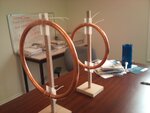Jeetkumar
Member level 1
 Hi All,
Hi All,I have a 1 inch copper tube bended into circular structure of 30 cm inner to inner diameter as shown in figure, i am using this tube for wireless power transmission system, i need to match this to 50 ohm coaxile cable, first of all i dont have any idea how to calculate impedance of tube and than how to make matching circuit, any help is appreciated.
Thanks in advance
Last edited: